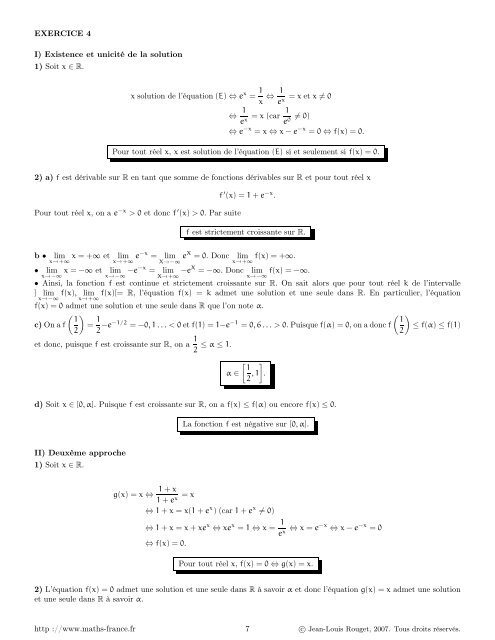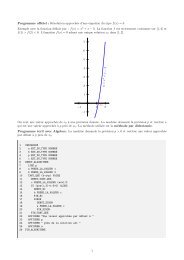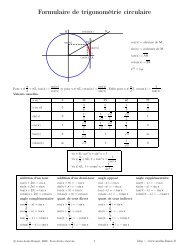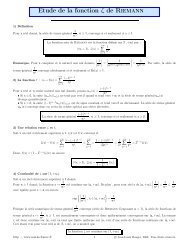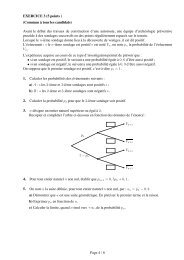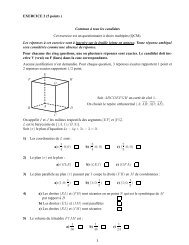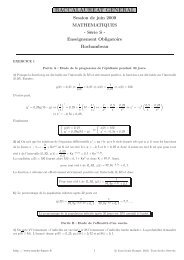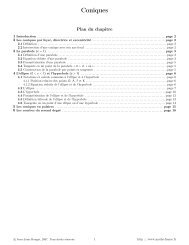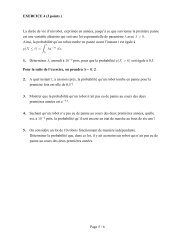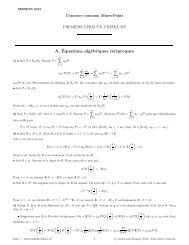EXERCICE 4 I) Existence et unicité de la solution 1 ... - Maths-france.fr
EXERCICE 4 I) Existence et unicité de la solution 1 ... - Maths-france.fr
EXERCICE 4 I) Existence et unicité de la solution 1 ... - Maths-france.fr
You also want an ePaper? Increase the reach of your titles
YUMPU automatically turns print PDFs into web optimized ePapers that Google loves.
<strong>EXERCICE</strong> 4<br />
I) <strong>Existence</strong> <strong>et</strong> <strong>unicité</strong> <strong>de</strong> <strong>la</strong> <strong>solution</strong><br />
1) Soit x ∈ R.<br />
x <strong>solution</strong> <strong>de</strong> l’équation (E) ⇔ e x = 1 1<br />
⇔ = x <strong>et</strong> x = 0<br />
x ex ⇔ 1 1<br />
= x (car = 0)<br />
ex e0 ⇔ e −x = x ⇔ x − e −x = 0 ⇔ f(x) = 0.<br />
Pour tout réel x, x est <strong>solution</strong> <strong>de</strong> l’équation (E) si <strong>et</strong> seulement si f(x) = 0.<br />
2) a) f est dérivable sur R en tant que somme <strong>de</strong> fonctions dérivables sur R <strong>et</strong> pour tout réel x<br />
Pour tout réel x, on a e −x > 0 <strong>et</strong> donc f ′ (x) > 0. Par suite<br />
f ′ (x) = 1 + e −x .<br />
f est strictement croissante sur R.<br />
b • lim x = +∞ <strong>et</strong> lim<br />
x→+∞ x→+∞ e−x = lim<br />
X→−∞ eX = 0. Donc lim f(x) = +∞.<br />
x→+∞<br />
• lim<br />
x→−∞<br />
x = −∞ <strong>et</strong> lim<br />
x→−∞ −e−x = lim<br />
X→+∞ −eX = −∞. Donc lim<br />
x→−∞<br />
f(x) = −∞.<br />
• Ainsi, <strong>la</strong> fonction f est continue <strong>et</strong> strictement croissante sur R. On sait alors que pour tout réel k <strong>de</strong> l’intervalle<br />
] lim f(x), lim f(x)[= R, l’équation f(x) = k adm<strong>et</strong> une <strong>solution</strong> <strong>et</strong> une seule dans R. En particulier, l’équation<br />
x→−∞ x→+∞<br />
f(x) = 0 adm<strong>et</strong> une <strong>solution</strong> <strong>et</strong> une seule dans R que l’on note α.<br />
<br />
1<br />
c) On a f =<br />
2<br />
1<br />
2 −e−1/2 = −0, 1... < 0 <strong>et</strong> f(1) = 1−e−1 <br />
1<br />
= 0, 6... > 0. Puisque f(α) = 0, on a donc f ≤ f(α) ≤ f(1)<br />
2<br />
<strong>et</strong> donc, puisque f est croissante sur R, on a 1<br />
≤ α ≤ 1.<br />
2<br />
α ∈<br />
<br />
1<br />
, 1 .<br />
2<br />
d) Soit x ∈ [0, α]. Puisque f est croissante sur R, on a f(x) ≤ f(α) ou encore f(x) ≤ 0.<br />
II) Deuxème approche<br />
1) Soit x ∈ R.<br />
g(x) = x ⇔<br />
1 + x<br />
La fonction f est négative sur [0, α].<br />
= x<br />
1 + ex ⇔ 1 + x = x(1 + e x ) (car 1 + e x = 0)<br />
⇔ 1 + x = x + xe x ⇔ xe x = 1 ⇔ x = 1<br />
e x ⇔ x = e−x ⇔ x − e −x = 0<br />
⇔ f(x) = 0.<br />
Pour tout réel x, f(x) = 0 ⇔ g(x) = x.<br />
2) L’équation f(x) = 0 adm<strong>et</strong> une <strong>solution</strong> <strong>et</strong> une seule dans R à savoir α <strong>et</strong> donc l’équation g(x) = x adm<strong>et</strong> une <strong>solution</strong><br />
<strong>et</strong> une seule dans R à savoir α.<br />
http ://www.maths-<strong><strong>fr</strong>ance</strong>.<strong>fr</strong> 7 c○ Jean-Louis Roug<strong>et</strong>, 2007. Tous droits réservés.
3) g est dérivable sur R en tant que quotient <strong>de</strong> fonctions dérivables sur R dont le dénominateur ne s’annule pas sur R <strong>et</strong><br />
pour tout réel x<br />
g ′ (x) = 1(1 + ex ) − (1 + x)e x<br />
(1 + e x ) 2<br />
= 1 − xex<br />
(1 + e x ) 2.<br />
Puisque pour tout réel x, on a (1+e x ) 2 > 0, g ′ (x) est pour tout réel x du signe <strong>de</strong> 1−xe x . Maintenant, d’après <strong>la</strong> question<br />
I)2)d), <strong>la</strong> fonction f est négative sur [0, α]. Soit alors x un réel <strong>de</strong> [0, α].<br />
f(x) ≤ 0 ⇒ x − e −x ≤ 0 ⇒ x ≤ e −x ⇒ x ≤ 1<br />
e x<br />
⇒ xe x ≤ 1 (car e x > 0)<br />
⇒ 1 − xe x ≥ 0.<br />
Finalement, <strong>la</strong> fonction g ′ est positive sur [0, α] <strong>et</strong> donc<br />
<strong>la</strong> fonction g est croissante sur [0, α].<br />
III) Construction d’une suite dé réels ayant pour limite α<br />
1) Montrons par récurrence que pour tout entier naturel n, 0 ≤ un ≤ un+1 ≤ α.<br />
1 + 0 1<br />
1<br />
• Déjà u0 = 0, puis u1 = = . Or, d’après <strong>la</strong> question I)2)c), α ≥<br />
1 + e0 2 2 ce qui montre que 0 ≤ u0 ≤ u1 ≤ α.<br />
L’encadrement est donc vrai quand n = 0.<br />
• Soit n ∈ N. Supposons que 0 ≤ un ≤ un+1 ≤ α. Puisque g est croissante sur [0, α], on en déduit que<br />
g(0) ≤ g(un) ≤ g(un+1) ≤ g(α) ou encore 1<br />
2 ≤ un+1 ≤ un+2 ≤ α <strong>et</strong> en particulier 0 ≤ un+1 ≤ un+2 ≤ α.<br />
On a montré par récurrence que<br />
pour tout entier naturel n, 0 ≤ un ≤ un+1 ≤ α.<br />
2) Ainsi d’une part, pour tout entier naturel n, un ≤ un+1 ce qui montre que <strong>la</strong> suite (un)n∈N est croissante. D’autre<br />
part, pour tout entier naturel n, un ≤ α ce qui montre que <strong>la</strong> suite (un)n∈N est majorée par α. En résumé <strong>la</strong> suite (un)n∈N<br />
est croissante <strong>et</strong> majorée <strong>et</strong> donc converge.<br />
La suite (un)n∈N converge.<br />
3) Notons ℓ <strong>la</strong> limite <strong>de</strong> <strong>la</strong> suite (un)n∈N. La fonction g est continue sur R <strong>et</strong> en particulier en ℓ. On en déduit que quand<br />
n tend vers +∞, g(un) tend vers g(ℓ). Par suite<br />
ℓ = lim<br />
n→+∞ un+1 = lim<br />
n→+∞ g(un) = g(ℓ).<br />
Ainsi, le réel ℓ est <strong>solution</strong> <strong>de</strong> l’équation g(x) = x. La question II)2) perm<strong>et</strong> alors d’affirmer que ℓ = α.<br />
La suite (un)n∈N converge vers α.<br />
4) On a u0 = 0 puis u1 = 0, 5. La machine fournit alors u2 = 0, 5663110032..., u3 = 0, 567143165... <strong>et</strong> finalement<br />
u4 = 0, 567143 arrondi à <strong>la</strong> sixième décimale.<br />
http ://www.maths-<strong><strong>fr</strong>ance</strong>.<strong>fr</strong> 8 c○ Jean-Louis Roug<strong>et</strong>, 2007. Tous droits réservés.


